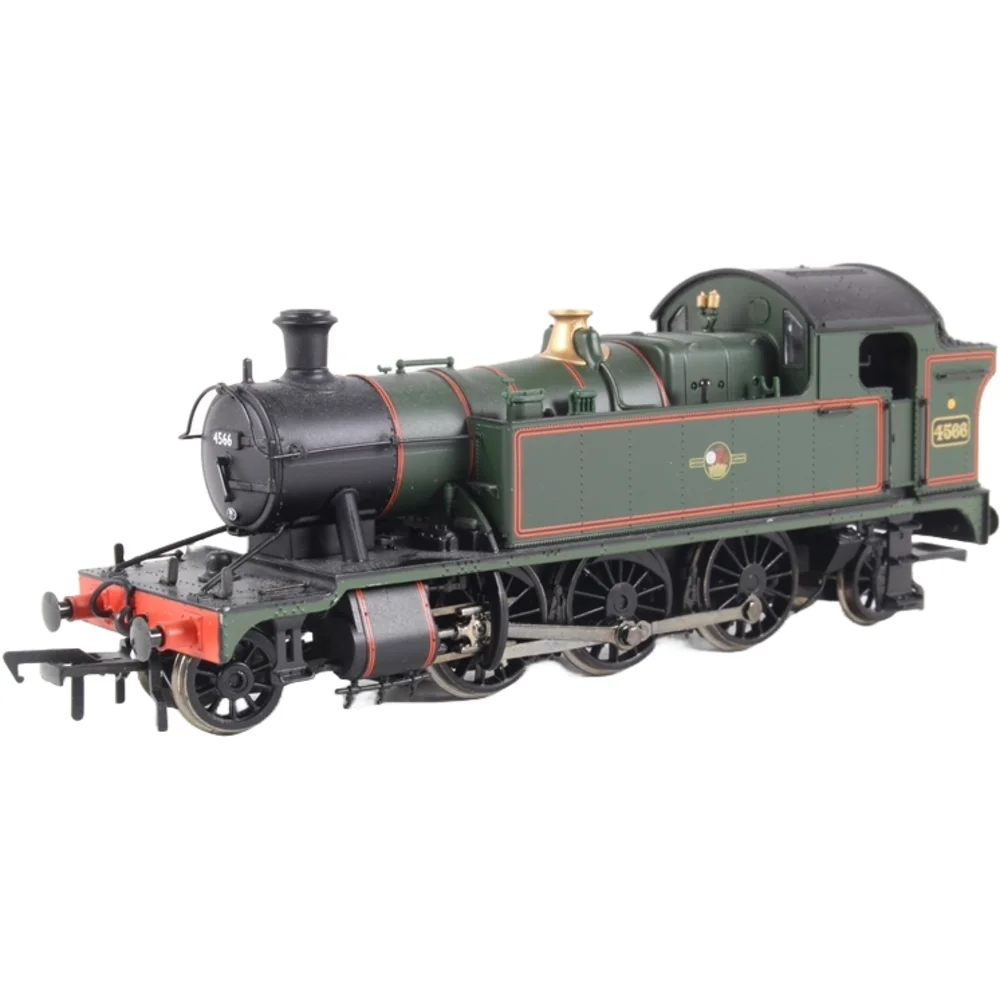Bachmann 32-125
Great Western Railway 4500 4566 British Railways Lined Green with Late Crest
Tooling
In 2003, Bachmann Branchline introduced its OO gauge model of the Great Western Railway (GWR) 4500 Class “Small Prairie” tank locomotive. This release marked a significant step forward in British outline modelling, replacing older, less detailed representations with a highly accurate and finely engineered model. The prototype, designed by Churchward, was a 2-6-2T locomotive built between 1906 and 1924 for mixed-traffic duties on branch lines.
Tooling Features
- Scale: OO (1:76)
- Construction: Die-cast chassis for weight and stability, plastic body shell with crisp moulding and rivet detail.
- Detailing: Separate handrails, accurate cab interior, fine pipework, and prototypical chimney and dome profiles.
- Couplings: Standard tension-lock couplers in NEM pockets.
Mechanical & Electrical
- Motor & Drive: Smooth-running can motor with worm drive to the centre axle.
- Weighting: Metal chassis provides good adhesion and realistic performance.
- Minimum Radius: Compatible with 1st radius curves (approx. 371 mm).
- Lighting: No factory lighting fitted.
DCC Capability
The initial 2003 tooling was DCC compatible but not ready. It featured a hard-wired motor without a factory-fitted socket. Later revisions (2012 onwards) introduced an 8-pin socket for easier digital conversion.
Liveries Produced
The first batch included GWR green, BR black, and BR lined green variants. These were followed by additional liveries and weathered versions in subsequent years.
Reviews & Commentary
Upon release, the model was praised for its accuracy, smooth running, and fine detailing, setting a new benchmark for branch line tank engines in OO scale. Model railway magazines highlighted its robust mechanism and realistic proportions. On forums and social media, enthusiasts noted the improvement over previous models, though some commented on the lack of DCC socket and lighting options in the original tooling.
Interesting Notes
- The tooling formed the basis for later variants, including the 4575 and 55xx classes.
- Its introduction coincided with Bachmann’s broader push for higher fidelity in British outline models during the early 2000s.
Class & Prototype
- Class: Great Western Railway 4500
- Traction: Steam
- Built: 1906-1924
- Total Built: 175
- Running Number: 4566
Operator & Livery
- Operator: British Railways
- Livery: Lined Green with Late Crest
- Era: 5 - British Railways Late Crest
British Railways transformed Britain's fragmented rail network into a unified national system following nationalisation on 1st January 1948. Created from the "Big Four" companies under the Transport Act 1947, BR operated most of Great Britain's railways until rebranding as British Rail in 1965, managing over 20,000 route miles and inheriting nearly 20,000 locomotives of diverse designs.
The organisation pioneered standardisation through its revolutionary BR Standard locomotive programme (1951-1960), producing 999 advanced steam engines under Robert Riddles' direction. These included the versatile Britannia Pacifics, mighty 9F freight engines, and mixed-traffic classes that incorporated the best features from all predecessor companies. The 1955 Modernisation Plan accelerated diesel and electric traction development, creating fascinating mixed-traction operations.
Notable achievements included establishing unified locomotive classification systems, introducing distinctive corporate liveries, and managing the complex transition from steam to modern traction. BR's six regional structure preserved operational diversity whilst enabling standardisation of practices, signalling, and rolling stock that had eluded private enterprise for over a century.
The BR era represents steam traction's final flowering alongside emerging diesel technology, creating unparalleled locomotive variety. Today, this heritage remains highly popular with railway enthusiasts through extensive preserved fleets, heritage railway operations, and comprehensive model ranges from manufacturers like Hornby, Bachmann, and Dapol, making BR subjects essential for authentic post-war British railway modelling across all scales.
British Railways' lined green livery continued for express passenger locomotives from 1956, painted in BS224 Deep Bronze Green (also known as Land Rover Deep Bronze Green) with orange and black lining, maintaining the prestigious finish for the railway's premier motive power. The livery was reserved for the most powerful express passenger classes, including Britannias, Castles, Kings, A4s, Merchant Navy Pacifics, and other premier locomotives rated for top-link express duties. From 1954 onwards, green became more widely adopted across the locomotive fleet, with some mixed-traffic engines also receiving the prestigious finish as regional freedom in livery matters increased following the 1953 Transport Act.
From mid-1956, these locomotives received the new "Lion and Crown" emblem (nicknamed the "Ferret and Dartboard"), a proper heraldic device registered with the College of Arms featuring a rampant lion emerging from a crown and holding a spoked wheel, all enclosed in a roundel with "British Railways" on bars either side. The emblem was positioned centrally on tender sides, with the heraldically correct lion facing left, though some locomotives initially received forward-facing applications during the transition period. Lettering and numbering remained in golden yellow Gill Sans Medium, maintaining the high-quality finish appropriate for express passenger duties. Regional variations in the shade of green occurred depending on which works applied the paint, the suppliers used, and the number of paint layers applied, creating subtle differences between locomotive classes and individual engines. This livery represented the final flowering of BR's steam-era corporate identity, combining technical excellence with heraldic dignity during the twilight years of express steam operations before the Rail Blue revolution of the mid-1960s.
